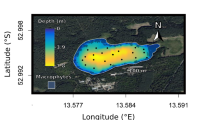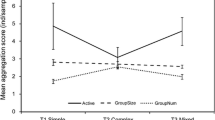Abstract
The mechanisms underpinning the structure of social networks in multiple fish populations were investigated. To our knowledge this is the first study to provide replication of social networks and therefore probably the first that allows general conclusions to be drawn. The social networks were all found to have a non-random structure and exhibited ‘social cliquishness’. A number of factors were observed to contribute to this structuring. Firstly, social network structure was influenced by body length and shoaling tendency, with individuals interacting more frequently with conspecifics of similar body length and shoaling tendency. Secondly, individuals with many social contacts were found to interact with each other more often than with other conspecifics, a phenomenon known as a ‘positive degree correlation’. Finally, repeated interactions between pairs of individuals occurred within the networks more often than expected by random interactions. The observed network structures will have ecological and evolutionary implications. For example, the occurrence of positive degree correlations suggests the possibility that pathogens and information (that are socially transmitted) could spread very fast within the populations. Furthermore, the occurrence of repeated interactions between pairs of individuals fulfils an important pre-requisite for the evolution of reciprocal altruism.



Similar content being viewed by others
References
Abramson G, Kuperman M (2001) Social games in a social network. Phys Rev E 6303:art. no. 030901
Albert R, Barabási AL (2002) Statistical mechanics of complex networks. Rev Mod Phys 74:47–97
Bell MA, Foster SA (eds) (1994) The evolutionary biology of the threespine stickleback. Oxford University Press, Oxford
Chivers DP, Brown GE, Smith RJF (1995) Familiarity and shoal cohesion in fathead minnows (Pimephales promelas)—implications for antipredator behaviour. Can J Zool 73:955–960
Croft DP et al (2003a) Mechanisms underlying shoal composition in the Trinidadian guppy (Poecilia reticulata). Oikos 100:429–438
Croft DP, Albanese B, Arrowsmith BJ, Botham M, Webster M, Krause J (2003b) Sex biased movement in the guppy (Poecilia reticulata). Oecologia 137:62–68
Croft DP, Krause J, Couzin ID, Pitcher TJ (2003c) When fish shoals meet: outcomes for evolution and fisheries. Fish Fisheries 4:138–146
Croft DP, Krause J, James R (2004a) Social networks in the guppy (Poecilia reticulata). Proc R Soc Lond Biol Lett 271:516–519
Croft DP, Botham MS, Krause J (2004b) Is sexual segregation in the guppy, Poecilia reticulata, consistent with the predation risk hypothesis? Environ Biol Fishes 71:127--133
Crowley PH (1992) Resampling methods for computation-intensive data-analysis in ecology and evolution. Annu Rev Ecol Syst 23:405–477
Dugatkin LA (1988) Do guppies play tit for tat during predator inspection visits. Behav Ecol Sociobiol 23:395–399
Dugatkin LA (1997) Cooperation among animals: an evolutionary perspective. Oxford University Press, New York
Farr JA (1977) Male rarity of novelty, female choice behaviour, and sexual selection in the guppy Poecilia reticulata (Pisces: Poeciliidae). Evolution 31:162–168
Griffiths SW (2003) Learned recognition of conspecifics by fishes. In: Brown C, Laland KN, Krause J (eds) Fish are smarter than you think: learning in fishes. Fish Fisheries (Spec Edn) 4:256–268
Griffiths SW, Magurran AE (1997) Schooling preferences for familiar fish vary with group size in a wild guppy population. Proc R Soc Lond Ser B Biol Sci 264:547–551
Houde AE (1997) Sex, color, and mate choice in guppies. Princeton University Press, Princeton
Hughes KA, Du L, Rodd FH, Reznick DN (1999) Familiarity leads to female mate preference for novel males in the guppy, Poecilia reticulata. Anim Behav 58:907–916
Krause J (1994) Differential fitness returns in relation to spatial positions in groups. Biol Rev 69:187–206
Krause J, Butlin R, Peuhkuri N, Pritchard VL (2000) The social organisation of fish shoals: a test of the predictive power of laboratory experiments for the field. Biol Rev 75:477–501
Lachlan RF, Crooks L, Laland KN (1998) Who follows whom? Shoaling preferences and social learning of foraging information in guppies. Anim Behav 56:181–190
Latora V, Marchiori M (2001) Efficient behavior of small-world networks. Phys Rev Lett 8719:art. no.198701
Lusseau D (2003) The emergent properties of a dolphin social network. Proc R Soc Lond Ser B Biol Sci 270:S186–S188
Magurran AE, Seghers BH, Shaw PW, Carvalho GR (1995) The behavioural diversity and evolution of guppy, Poecilia reticulata, populations in Trinidad. Adv Stud Behav 24:155–202
Milgram S (1967) The small-world problem. Psychol Today 2:60–67
Milinski M (1987) TIT FOR TAT in sticklebacks and the evolution of co-operation. Nature 325:433–435
Milinski M, Pfluger D, Kulling D, Kettler R (1990) Do sticklebacks cooperate repeatedly in reciprocal pairs? Behav Ecol Sociobiol 27:17–21
Moore C, Newman MEJ (2000) Epidemics and percolation in small-world networks. Phys Rev E 61:5678–5682
Newman MEJ (2003) The structure and function of complex networks. SIAM Rev 45:167–256
Pastor-Saorras R, Vazquez A, (2001) Dynamical and correlation properties of the Internet. Phys Rev Lett:art. no. 258701
Ranta E, Lindström K (1990) Assortative schooling in 3-spined sticklebacks. Ann Zool Fenn 27:67–75
Ranta E, Peuhkuri N, Laurila A (1994) A theoretical exploration of antipredatory and foraging factors promoting phenotype-assorted fish schools. Ecoscience 1:99–106
Theodorakis CW (1989) Size segregation and the effects of oddity on predation risk in minnow schools. Anim Behav 38:496–502
Utne-Palm AC, Hart PJB (2000) The effects of familiarity on competitive interactions between threespined sticklebacks. Oikos 91:225–232
Van Deventer JS, Platts WS (1983) Sampling and estimating fish populations from streams. Trans N Am Wild Nat Res 48:349–354
Van Deventer JS, Platts WS (1985) A computer software system for entering, managing, and analyzing fish capture data from streams. Research Note INT-352. Ogden, UT: U.S. Department of Agriculture, Forest Service. Intermountain Forest and Range Experiment Station
Ward AJW et al (2002) Association patterns and shoal fidelity in the three-spined stickleback. Proc R Soc Lond Ser B Biol Sci 269:2451–2455
Ward AJW, Hart PJB (2003) The effects of kin and familiarity on interactions between fish. Fish Fisheries 4:348–358
Watts DJ, Strogatz SH (1998) Collective dynamics of ‘small-world’ networks. Nature 393:440–442
Whitehead H, Dufault S (1999) Techniques for analyzing vertebrate social structure using identified individuals: review and recommendations. In: Advances in the study of behavior, vol 28. Academic, San Diego, pp 33–74
Acknowledgements
We would like to thank Bethany Arrowsmith and Michael Webster for their assistance in collecting the data in the field and Christina Prell for advice on social network analysis. We would also like to thank Ronnie Hernandez and the board of Asa Wright Nature Centre, Trinidad, for their continued support and assistance in the field. D.P.Croft would like to acknowledge funding from the Frank Parkinson scholarship (University of Leeds), FSBI and the Leverhulme trust.
Author information
Authors and Affiliations
Corresponding author
Rights and permissions
About this article
Cite this article
Croft, D.P., James, R., Ward, A.J.W. et al. Assortative interactions and social networks in fish. Oecologia 143, 211–219 (2005). https://doi.org/10.1007/s00442-004-1796-8
Received:
Accepted:
Published:
Issue Date:
DOI: https://doi.org/10.1007/s00442-004-1796-8




